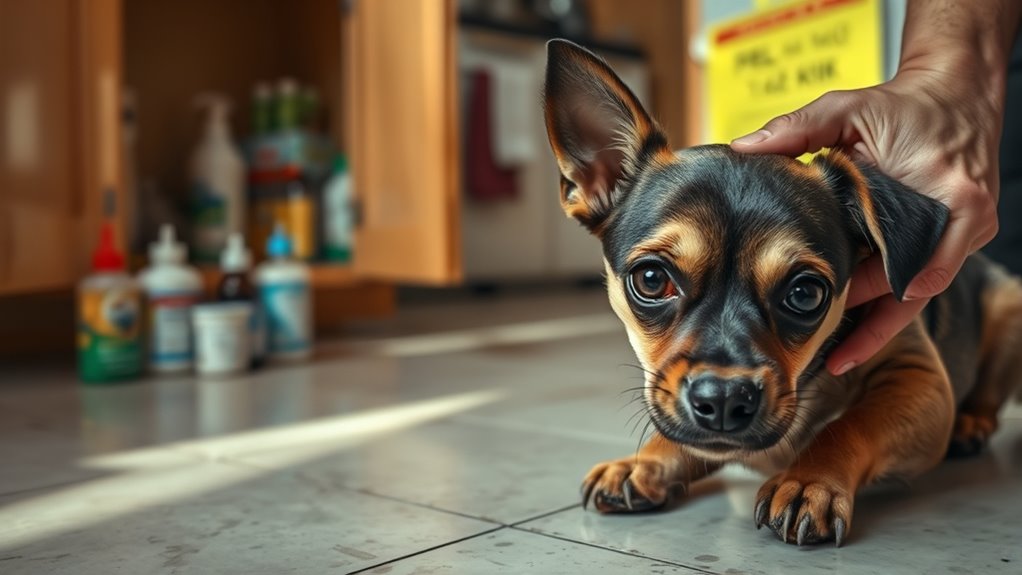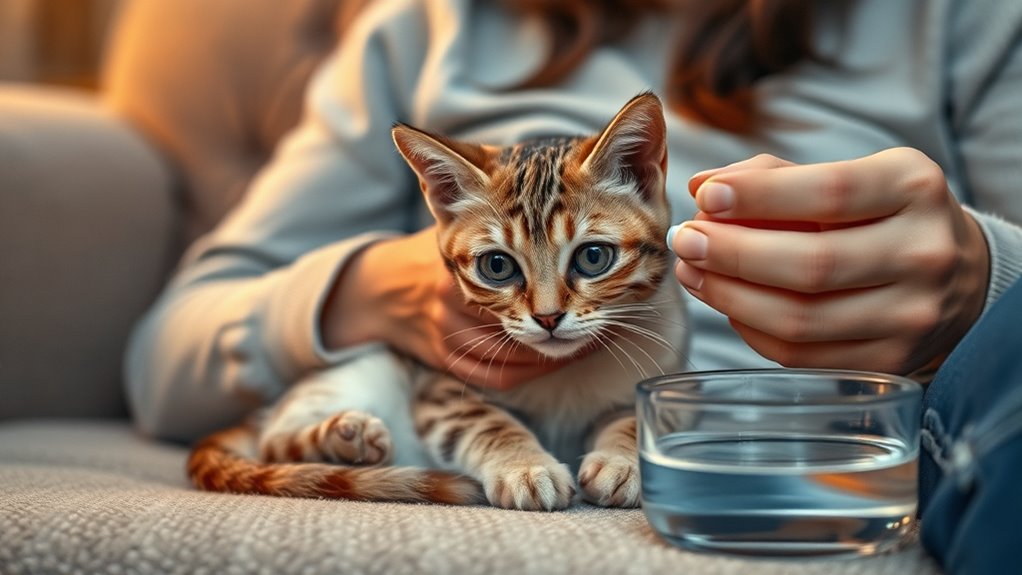If your pet ingests toxins, act quickly by removing them from the source and gathering the container or label for reference. Do not give food or water unless advised by a vet and avoid trying to induce vomiting yourself. Contact your emergency veterinarian or poison control immediately for guidance. Staying calm and acting fast can make a difference — learn tips to handle these urgent situations effectively.
Key Takeaways
- Remove your pet from the toxin source immediately and prevent further ingestion.
- Contact your veterinarian or emergency pet poison control right away for guidance.
- Gather information on the ingested substance, including containers and labels.
- Do not induce vomiting or give food/water unless instructed by a professional.
- Follow your vet’s instructions for treatment and monitoring to ensure your pet’s safety.

Pet poisoning emergencies can happen unexpectedly and require immediate action to save your pet’s life. One common cause of such emergencies is your pet ingesting toxic plants or household chemicals. Recognizing the signs and knowing what to do can make all the difference between a quick recovery and a tragedy.
Many household plants are toxic to pets, so it’s essential to identify which ones are dangerous. For example, lilies, azaleas, and sago palms can cause severe symptoms if ingested, including vomiting, diarrhea, or even organ failure. If you notice your pet munching on any plant, don’t wait for symptoms to appear—remove the plant immediately and contact your veterinarian. Keep plants out of reach or opt for pet-safe alternatives to prevent accidental ingestion. Understanding color accuracy in relation to visual cues can also aid in assessment, as some toxins cause subtle changes in your pet’s appearance. Additionally, being familiar with common household toxins can help you act swiftly in an emergency, especially when recognizing early signs of poisoning.
Household chemicals are another common source of poisoning. From cleaning agents to medications, they’re often within easy reach in households. Common culprits include bleach, toilet bowl cleaners, antifreeze, and certain fertilizers or pesticides. If your pet manages to ingest any of these substances, your first step should be to act swiftly. Don’t try to induce vomiting unless instructed by a vet, as some chemicals can cause more damage if vomited back up. Instead, gather the container or label to help your vet understand what was ingested and call your emergency vet line immediately. Remember, poison control resources can provide vital guidance in these situations, especially when timing is critical.
Time is critical in poisoning cases. The faster you respond, the better the chance your pet will recover. If possible, remove your pet from the source of toxins to prevent further ingestion. Check their mouth for any remaining chemicals or plant material, but don’t attempt to give them food or water unless directed by a professional, as this can sometimes worsen the situation. Additionally, being aware of local veterinary resources can ensure prompt treatment if needed. Knowing how toxins affect pets can also help you understand the urgency and severity of symptoms, enabling quicker decision-making.
Your vet might advise bringing your pet in for treatment or may suggest administering activated charcoal at home to absorb toxins. Never try to treat poisoning on your own without professional guidance. Keep the contact information for your emergency vet and the ASPCA Animal Poison Control Center handy, so you can reach out immediately. Remember, swift, calm action can make all the difference. Being aware of the dangers posed by toxic plants and household chemicals and knowing how to respond can help you protect your pet from life-threatening poisonings.
Frequently Asked Questions
How Can I Prevent Accidental Poisoning in My Pets?
To prevent accidental poisoning in your pets, you should prioritize medication safety by storing drugs out of their reach. Keep household chemicals in secure cabinets and avoid leaving them where pets can access. Regularly check your environment for potential hazards and educate everyone in your home about the risks. By taking these precautions, you reduce the chances of your pets ingesting harmful substances and guarantee their safety.
Are Certain Dog Breeds More Susceptible to Poisoning?
Certain dog breeds have higher susceptibility to poisoning due to genetic predispositions, making them more vulnerable to toxins. Breeds like Dobermans, Boxers, and Collies may have enzyme deficiencies or sensitivities that increase their risk. To protect your pet, learn about your breed’s specific susceptibilities, keep toxins out of reach, and consult your veterinarian for tailored advice. Being aware of breed susceptibility helps you prevent accidental poisoning effectively.
What Are the Long-Term Effects of Pet Poisoning?
You might wonder about the long-term effects of pet poisoning. If your pet ingests toxins, it can lead to chronic health issues like liver or kidney damage, which may not show immediate symptoms. Behavioral changes, such as lethargy or aggression, can also occur over time. Early treatment is vital to minimize these effects, so monitoring your pet and consulting your vet helps reduce potential long-term health problems.
Can Indoor Plants Be Toxic to Pets?
Like Pandora’s box, indoor plants can hold hidden dangers. You should be aware that some plants pose serious risks due to plant toxicity, potentially harming your pet’s health. Always research your indoor plants for pet safety and avoid those known to be toxic. Keeping an eye on your pets and removing hazardous plants ensures their safety, preventing accidental poisoning and safeguarding their well-being.
How Do I Identify if My Pet Has Ingested Toxins?
To identify if your pet has ingested toxins, watch for symptom recognition and emergency symptoms. Look for vomiting, drooling, diarrhea, difficulty breathing, or seizures. Keep a close eye on their behavior—lethargy, disorientation, or tremors can also signal poisoning. If you notice any of these signs, act quickly and seek immediate veterinary care. Prompt action can make a vital difference in your pet’s recovery.
Conclusion
Remember, acting quickly can make all the difference. If your dog eats grapes, for instance, it could lead to serious kidney issues. Always keep toxins out of reach and know the signs of poisoning. If you suspect your pet has ingested something harmful, don’t wait—contact your vet immediately. Taking swift action can save your pet’s life. Your prompt response and preventive measures are your best tools in these emergencies.










